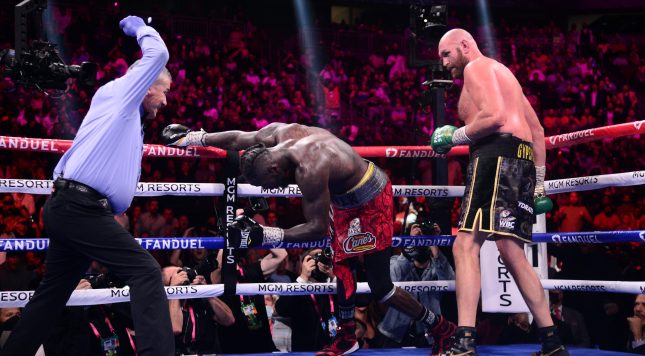When sports equal the artistic merit produced in fiction, one of the ways it happens is as unscripted drama with narratives as rich as the unreal.
Within seconds of the opening bell one October night, Tyson Fury vs Deontay Wilder 3 started piling on the narratives that ensured we were about to get that kind of art. And until it ended, it never stopped spiraling into epic, unknowable directions.
Consider: As excellent as we all know it is in hindsight, Fury vs Wilder 3 wasn’t welcome for most until that opening bell. The first bout was a classic, delivering one of the most “what the hell” moments in boxing memory when Fury got off the canvas in the 12th after looking as though he was surely done for. It was a draw, one that most thought Fury deserved to win for his 12-round body of work punctuated by the knockdowns he suffered, making the slaughter he unleashed on Wilder in the second bout all the proof we needed of who the better man was.
And yet moments into the 1st round of the third encounter, here we had Wilder — a dangerous fighter not because of all the things he can do, but because of the lone thing he does so well, which is to deliver one of the most concussive right hands in the history of boxing — suddenly displaying more than a solitary dimension. He was… jabbing to Fury’s stomach? Huh? It was more than enough to reveal that, oh, there may be layers to the Wilder-Fury story yet untold after all. Because Fury looked as confused as the rest of us, like perhaps he’d taken Wilder lightly, too.
What eventually unfurled was surprise after surprise. Despite Wilder’s intriguing start, it was Fury who would drop Wilder first, in the 3rd round. Another reversal in the very next stanza: Wilder would knock down Fury, in turn, and then again in the same round for good measure. Another: Fury would regain momentum and keep it for most of the rest of the night.
Yet even that pattern had its own “how is this possible?” twists, with Wilder, perpetually one semi-connect away from victory, repeatedly surging back to life for spurts out of nowhere that had anyone watching wondering if we were about to see yet another ridiculously insane turnabout.
At a certain point, the continual existence of Wilder’s consciousness after the beating he was taking was its own mini-story. Boxers just aren’t human in the same way the rest of us are.
And of course — of course! — it ended with a huge knockout. (For Fury, in the 11th.)
Occasionally, this sport delivers fighters who were born to face one another; occasionally, they even actually do meet in the ring. Obviously, that’s the case for Fury-Wilder, and we got it three times. In 2021, we were blessed with another such a pairing as Roman Gonzalez finally rematched Juan Francisco Estrada on the far end of the scale, for the junior bantamweight championship as opposed to the heavyweight one.
The TQBR team, interestingly, split 50-50 on their votes in all three year-end categories. It’s easy to see why Estrada-Gonzalez 2 won such favor. You don’t get much more evenly-matched, sustained, high-level action from such talented and skilled combatants as you got in that one.
If Fury-Wilder 3 had an edge, it was because of its sheer unpredictability from beginning to end. Even after, the bitter Wilder-Fury feud added another chapter: Spiteful and unsportsmanlike as he had been after his loss to Fury, Wilder refused to shake his foe’s hand. Compared to anything else that happened in 2021, this fight was wilder. And it was filled with ample fury.
(Oct 9, 2021; Las Vegas, Nevada; Deontay Wilder [red/black trunks] is knocked out by Tyson Fury [black/gold trunks] during their Lineal heavyweight championship boxing match at T-Mobile Arena. Credit: Joe Camporeale-USA TODAY Sports)

